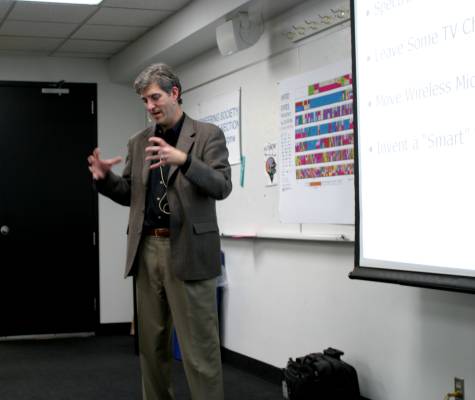

Chris Lyons, Shure Inc. |

The Audience |
The PNW Section met October 16, 2007 at the Art Institute of Seattle, to hear about issues concerning the impending radio frequency spectrum reallocation in the U.S. The meeting was presented in association with WAPS (Washington Association of Production Services), a local organization of businesses providing concert sound and lighting. About 38 attended (14 of which were AES members). Chris Lyons, Shure's Manager of Technical & Educational Communications, was assisted by Luis Guerra, Shure Sales Engineer, in the talk.
Chris explained the current radio spectrum allocation picture and the historical reasoning behind the U.S. Federal Communications Commission (FCC) management of the spectrum regarding wireless microphones. He then continued with the technical problems created by the currently proposed frequency reallocations, possible answers, and the current state of the debate.
Rearranging use of the radio spectrum is not new, but changes are underfoot currently that will affect wireless microphone users. The transition from analog TV to HDTV, a call for better public safety radio communications, and new technologies like portable information devices are driving the reallocation. Most of what is called "whitespace" are UHF TV channels that will become open once analog TV broadcasts cease in February 2009. However, they are generally slated to be allocated to other uses besides wireless microphones, leaving a huge question as to how wireless microphones will be able to operate in the future.
U.S. government forces and lobbyists on both sides of the issue are still in play and arguing on the best course of action. There is some indication that the looming U.S. HDTV cutoff date might delay decisions on wireless microphone solutions. One idea being floated includes devices that would sense whether a frequency is in use (as by a wireless microphone), and use another channel. Early tests, however, have failed. Other ideas include leaving certain channels open, looking for other spectrum space, or even "smart microphones" (yet to be invented - maybe an SM58 like a Blackberry) or some combination.
Chris felt that users who are concerned should contact their congresspeople and voice their concern. What he feels is needed for the wireless microphone industry is operating protection that works, open testing of the proposed solutions, and adequate time to implement solutions.
Door prize winners were:
Reported by Gary Louie, PNW Section Secretary.
Last modified 1/28/2008.